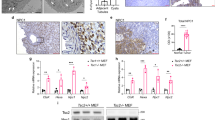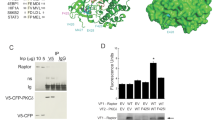Abstract
The tuberous sclerosis complex gene 2 (TSC2)/mammalian target of rapamycin (mTOR) pathway controls many cellular functions via phosphorylation of ribosomal protein S6 kinases (S6Ks). Alternative splicing and translation generate three S6K1 proteins. Although nuclear and cytoplasmic S6K targets are known, the nucleocytoplasmic localization of the S6K1 proteins has not been comparatively elucidated so far. We show that in primary fibroblasts p85 S6K1 is cytoplasmic, p70 can be found in both compartments and p31 is exclusively nuclear. As already known for p70 and p85, our data suggest that p31 is also a target of mTOR-mediated phosphorylation. Blocking mTOR kinase activity via rapamycin and its activation in TSC2−/− cells and via TSC2 small interfering RNAs revealed that it regulates the localization of p70, but not of p85 and p31. The mTOR-dependent phosphorylation of p70 S6K1 at T389 is essential for its nuclear localization and exclusively hyperphosphorylated p70 S6K1 can be found in the nucleus. We further demonstrate this mTOR-controlled p70 S6K1 localization to be growth factor dependent. During the cell-cycle phosphorylation and nuclear localization of p70 S6K1 occur in mid G1 phase. We report that the different S6K1 proteins exhibit different nucleocytoplasmic localizations and that the TSC2/mTOR cascade not only regulates p70 S6K1 activity, but also its localization. These findings provide new important insights into the temporal and spatial dynamics of TSC2/mTOR/S6K regulation.
This is a preview of subscription content, access via your institution
Access options
Subscribe to this journal
Receive 50 print issues and online access
$259.00 per year
only $5.18 per issue
Buy this article
- Purchase on Springer Link
- Instant access to full article PDF
Prices may be subject to local taxes which are calculated during checkout








Similar content being viewed by others
Abbreviations
- mTOR:
-
mammalian target of rapamycin
- PI3K:
-
phosphatidylinositol-3-kinase
- siRNA:
-
small interfering RNA
- S6K:
-
ribosomal protein S6 kinase
- TSC2:
-
tuberous sclerosis complex gene 2
References
Cheatham L, Monfar M, Chou MM, Blenis J . (1995). Structural and functional analysis of pp70S6K. Proc Natl Acad Sci USA 92: 11696–11700.
Chiang GG, Abraham RT . (2007). Targeting the mTOR signaling network in cancer. Trends Mol Med 13: 433–442.
Coffer PJ, Woodgett JR . (1994). Differential subcellular localization of two isoforms of p70 S6 protein kinase. Biochem Biophys Res Com 198: 780–786.
Edelmann HML, Kühne C, Petritsch C, Ballou LM . (1996). Cell cycle regulation of p70 S6 kinase and p42/p44 mitogen-activated protein kinases in swiss mouse 3T3 fibroblasts. J Biol Chem 271: 963–971.
Fenton TR, Gout IT . (2011). Functions and regulation of the 70kDa ribosomal S6 kinases. Int J Biochem Cell Biol 43: 47–59.
Hengstschläger M, Bettelheim D, Rosner M, Repa C, Deutinger J, Bernaschek G . (2001). Extended prenatal survival of a non-mosaic trisomy 22 with aneuploid cytotrophoblasts. Prenat Diagn 21: 897–899.
Holz MK, Ballif BA, Gygi SP, Blenis J . (2005). mTOR and S6K1 mediate assembly of the translation initiation complex through dynamic interchange and ordered phosphorylation events. Cell 123: 569–580.
Kanazawa T, Taneike I, Akaishi R, Yoshizawa F, Furuya N, Fujimura S et al. (2004). Amino acids and insulin control authophagic proteolysis through different signaling pathways in relation to mTOR in isolated rat hepatocytes. J Biol Chem 279: 8452–8459.
Karni R, Stanchina E, Lowe SW, Sinha R, Mu D, Krainer AR . (2007). The gene encoding the splicing factor SF2/ASF is a proto-oncogene. Nat Struct Mol Biol 14: 185–193.
Kim D, Akcakanat A, Singh G, Sharma C, Meric-Bernstam F . (2009). Regulation and localization of ribosomal protein S6 kinase 1 isoforms. Growth Factors 27: 12–21.
Kim JE, Chen J . (2000). Cytoplasmic-nuclear shuttling of FKBP12-rapamycin associated protein is involved in rapamycin-sensitive signaling and translation initiation. Proc Natl Acad Sci USA 97: 14340–14345.
Kim S-J, Kahn CR . (1997). Insulin stimulates p70 S6 kinase in the nucleus of cells. Biochem Biophys Res Com 234: 681–685.
Knowles MA, Habuchi T, Kennedy W, Cuthbert-Heavens D . (2003). Mutations spectrum of the 9q34 tuberous sclerosis gene TSC1 in translational cell carcinoma of the bladder. Cancer Res 63: 7652–7656.
Meyuhas O, Dreazen A . (2010). Ribosomal protein S6 kinase: from TOP mRNAs to cell size. Progr Mol Biol Translat Sci 90: 109–153.
Panasyuk G, Nemazanyy I, Zhyvoloup A, Bretner M, Litchfield DW, Filonenko V et al. (2006). Nuclear export of S6K1 II is regulated by protein kinase CK2 phosphorylation at Ser17. J Biol Chem 281: 31188–31201.
Plas DR, Thomas G . (2009). Tubers and tumors: rapamycin therapy for benign and malignant tumors. Curr Op Cell Biol 21: 230–236.
Reinhard C, Fernandez A, Lamb NJC, Thomas G . (1994). Nuclear localization of p85S6K: functional requirement for entry into S phase. EMBO J 13: 1557–1565.
Rosner M, Hengstschläger M . (2008). Cytoplasmic and nuclear distribution of the protein complexes mTORC1 and mTORC2: rapamycin triggers dephosphorylation and delocalization of the mTORC2 components rictor and sin1. Hum Mol Genet 17: 2934–2948.
Rosner M, Freilinger A, Hanneder M, Fujita N, Lubec G, Tsuruo T et al. (2007). p27Kip1 localization depends on the tumor suppressor protein tuberin. Hum Mol Genet 16: 1541–1556.
Rosner M, Fuchs C, Siegel N, Valli A, Hengstschläger M . (2009). Functional interaction of mammalian target of rapamycin complexes in regulating mammalian cell size and cell cycle. Hum Mol Genet 18: 3298–3310.
Rosner M, Siegel N, Fuchs C, Slabina N, Dolznig H, Hengstschläger M . (2010). Efficient siRNA-mediated prolonged gene silencing in human amniotic fluid stem cells. Nat Protoc 5: 1081–1095.
Ruvinsky I, Meyuhas O . (2006). Ribosomal protein S6 phosphorylation: from protein synthesis to cell size. Trends Biochem Sci 31: 342–346.
Sancak Y, Peterson TR, Shaul YD, Lindquist RA, Thoreen CC, Peled L et al. (2008). The Rag GTPases bind raptor and mediate amino acid signalling to mTORC1. Science 320: 1496–1501.
Schalm SS, Blenis J . (2002). Identification of a conserved motif required for mTOR signaling. Curr Biol 12: 632–639.
Schalm SS, Tee AR, Blenis J . (2005). Characterization of a conserved C-terminal motif (RSPRR) in ribosomal protein S6 kinase 1 required for its mammalian target of rapamycin-dependent regulation. J Biol Chem 280: 11101–11106.
Sengupta S, Peterson TR, Sabatini DM . (2010). Regulation of the mTOR complex 1 pathway by nutrients, growth factors, and stress. Mol Cell 40: 310–322.
Shaw RJ . (2008). mTOR signaling: RAG GTPases transmit the amino acid signal. Trends Biochem Sci 33: 565–568.
Shin I, Rotty J, Wu FY, Arteaga CL . (2005). Phosphorylation of p27Kip1 at Thr-157 interferes with its association with importin alpha during G1 and prevents nuclear re-entry. J Biol Chem 280: 6055–6063.
Wang X, Proud CG . (2009). Nutrient control of TORC1, a cell-cycle regulator. Trends Cell Biol 19: 260–267.
Weng Q-P, Andrabi K, Kozlowski MT, Grove JR, Avruch J . (1995). Multiple independent inputs are required for activation of the p70 S6 kinase. Mol Cell Biol 15: 2333–2340.
Yang Q, Guan K-L . (2007). Expanding mTOR signaling. Cell Res 17: 666–681.
Acknowledgements
Research in our laboratory is supported via grants from the Herzfelder'sche Familienstiftung and the Österreichische Nationalbank.
Author information
Authors and Affiliations
Corresponding author
Ethics declarations
Competing interests
The authors declare no conflict of interest.
Rights and permissions
About this article
Cite this article
Rosner, M., Hengstschläger, M. Nucleocytoplasmic localization of p70 S6K1, but not of its isoforms p85 and p31, is regulated by TSC2/mTOR. Oncogene 30, 4509–4522 (2011). https://doi.org/10.1038/onc.2011.165
Received:
Revised:
Accepted:
Published:
Issue Date:
DOI: https://doi.org/10.1038/onc.2011.165
Keywords
This article is cited by
-
S6K1 controls adiponectin expression by inducing a transcriptional switch: BMAL1-to-EZH2
Experimental & Molecular Medicine (2022)
-
Direct imaging of the recruitment and phosphorylation of S6K1 in the mTORC1 pathway in living cells
Scientific Reports (2019)
-
Cytoplasmic localization of programmed cell death 4 contributes to its anti-apoptotic function
Molecular and Cellular Biochemistry (2018)
-
Human stem cells alter the invasive properties of somatic cells via paracrine activation of mTORC1
Nature Communications (2017)
-
IKK-β mediates hydrogen peroxide induced cell death through p85 S6K1
Cell Death & Differentiation (2013)



